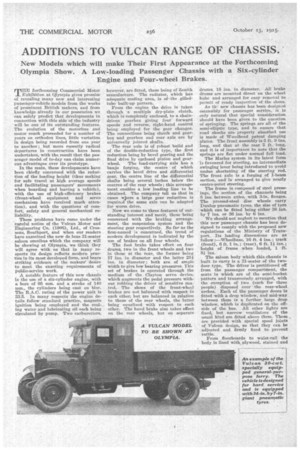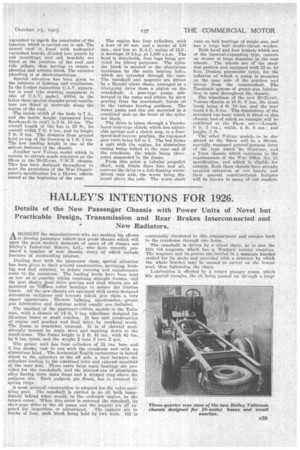ADDITIONS TO VULCAN RANGE OF CHASSIS.
Page 22

Page 23

If you've noticed an error in this article please click here to report it so we can fix it.
New Models which will make Their First Appearance at the Forthcoming Olympia Show. A Low-loading Passenger Chassis with a Six-cylinder Engine and Four-wheel Brakes.
THE forthcoming Commercial Motor Exhibition at Qlympia gives promise of revealing many new and interesting passenger-vehicle models from the works of prominent British makers, and from knowledge already in our possession we can safely predict that developments in connection with this side of the industry will be one of its outstanding features. The evolution of the motorbus and motor coach proceeded for a number of years on orthodox lines, little variation in design being recorded from one year to another ; but more recently radical departures in construction have been undertaken, with the result that the passenger model of to-day can claim numerous advantages over its prototype.
In the main, these developments have been chiefly concerned with the reduction of the loading height (thus making for safe travel at high average speeds and facilitating passengers' movements when boarding and leaving a vehicle), with the use of high-efficiency brakes (front-wheel equipment and servo mechanism have received much attention), and with the questions of comfort, safety and general mechanical reliability.
These problems have come under the careful notice of the Vulcan Motor and Engineering Co. (1906), Ltd., of Crossens, Southport, and when our readers have examined the new de luxe 31-seater saloon omnibus which the company will be showing at Olympia, we think they will agree with us that in many respects its design reflects modern practice in its most developed form, and bears striking evidence of the makers' desire to meet the exacting requirements of public-service work.
A notable feature of this new chassis is the use of a eix-cylinder engine, with a bore of 95 mm. and a stroke of 140 mm., the cylinders being cast en bloc. The R.A.C. rating of the power unit is 33.5. In many respects the engine details follow standard practice, magneto ignition being employed and the cool-_ ing water and lubricating oil each being circulated by pump. Two carburetters, however, are fitted, these being of Zenith manufacture. The radiator, which has adequate cooling area, is of-the gilledtube built-up pattern.
From the engine the drive is taken through a multiple dry-plate clutch, which is completely enclosed, to a chaindriven gearbox giving four forward speeds and reverse, right-hand control being employed for the gear changes. The connections being clutch and gearbox and gearbox and rear axle are by universally jointed shafts.
The rear axle is of robust build And of the double-reduction type, the first reduction being by bevel gearing and the final drive by enclosed pinion and gearwheel. The load-carrying axle has a banjo forging, the centre of which carries the bevel drive and differential gear, the centre line of the differential shafts being several inches below the centres of the rear wheels; this arrangement enables a low loading line to be obtained. The company tell us that in cases were a large gear reduction is requirud the same axle can be adapted for worm drive.
Now we come to three features of outstanding interest and merit, these being concerned with the braking arrangement, the suspension 'system and the steering gear respectively. So far as the first-named ;s concerned, the trend of modern development is indicated by the use of brakes on all four wheels.
The foot brake takes effect on four drums, two in the front wheels and two in those at the rear, the former being 17 ins, in diameter and the latter 21-1 ins, in diameter ; both are of ample width to give low bearing pressures. This set of brakes is operated through the medium of the Clayton servo device, which augments the pedal pressure without robbing the driver of sensitive control. The shoes of the front-wheel brakes are not balanced with respect to each other, but are balanced in relation to those of the rear wheels, the latter being equalized with respect to each other. The hand brake also takes effect on the rear wheels, but on separate drums, 18 ins, in diameter. All brake drums are mounted direct on the wheel hubs and arranged for easy removal to permit of ready inspection of the shoes.
As th^ new chassis has been desigozei ostensibly for passenger service, it is only natural that special consideration should have been given to the question of springing. The springs are all of the semi-elliptic type, and to ensure that road shocks are properly absorbed use is made of Woodhead patent damping plates. The front assembly is 3 ft. 9 ins. long, and that at the rear 5 ft. long, and it is of importance to note that the springs are fiat under normal full load.
The Merles system in its latest forns is favoured for steering, an intermediate swinging lever being introduced to avoid undue shortening of the steering rod. The front axle is a forging of I-beam section, and is arranged to give nearly centre-point steering.
The frame is composed of steel pressings, the section of the channels being 8 ins, between axles, with 3-in. flanges. The pressed-steel disc wheels carry Dunlop pneumatic tyres, the size of tyre which can be fitted being either 38 ins. by 7 ins. or 36 ins. by 6 ins.
We should not neglect to mention that this new passenger chassis has been designed to comply with the proposed new regulations of the Ministry of Transport. Its leading dimensions are as follow :—Wheelbase, 16 ft. 4 ins.; track (front), 6 ft. 1 in. ; (rear), 6 ft. 1i ins. • height of frame when loaded, 1 ft 84 ins.
The saloon body which this chassis is built to carry is a 31-seater of the twodoor type. The driver is partitioned off from the passenger compartment, the seats in which are of the semi-bucket pattern and transversely arranged, with the exception of two (each for three people) disposed over the rear-wheel arches. Each of the passenger doors is fitted with a drop window, and mid-way between them is a further large drop window, which is duplicated on the offside of the bus. All other lights are fixed, hut narrow ventilators of the usual kind are fitted above them. These , are provided with special spool joints of Vulcan design, so that they can be adjusted and firmly fixed to prevent rattle.
From floorboards to waist-rail the body is lined with, plywood, stained and varnished to match the remainder of the interior, which is carried out in oak. The domed roof is lined with mahogany varnished boards, divided into panels by oak mouldings, and oak brackets are fitted at the junction of the roof and side pillars, thus serving to create a pleasing and artistic finish. The exterior panelling is of sheet-aluminium.
Special attention has been given to the subjects of lighting and ventilation. In the former connection C.A.V. apparatus is used (the starting equipment is also of C.A.V. make), whilst in the latter three special draught-proof ventilators are fitted at intervals along the centre of the roof.
The inside width of the body is 7 ft., and the inside height (measured from floorboards to roof) is 5 ft. 10 ins. The overall length of the bus is 26 ft., its overall width 7 ft. 4 ins., and its height 7 ft. 9 ins. The distance from ground level to top of the doorstep is 1 ft. 3 ins. The low loading height is one of the salient features of the chassis.
Another new Vulcan model which is certain to attract much attention at the Show is the 20-25-cwt. -V.W.T. chassis. This has been designed throughout to meet the provisions of the War Department's specification for a 15-cwt. vehicle issued at the beginning of the year.
The engine has four cylinders, with a bore of 80 mm. and a stroke of 130 mm., and has an R.A.C. rating of 15.9; it develops 18 b.h.p. at 1,000 r.p.m. The head is detachable, four lugs being provided for lifting purposes. The cylinder block is secured to the aluminium crankcase by the main bearing bolts, which are extended through the case. The camshaft and magneto are driven by a Renold silent chain, arranged as a triangular drive from a pinion OD the crankshaft. A gear-type pump, cabmerged in the sump and driven by skew gearing from the crankshaft, forces oil to the various bearing surfaces. The water pump and fan are mounted as a combined unit on the front of the cylinder block.
The drive is taken through a Ferodofaced cone-type clutch, which has adjustable springs and a clutch stop, to a fourspeed-and-reverse gearbox, the top-speed gear ratio being 6.5 to 1, The box forms a unit with the engine, its aluminium casing being bolted to the rear and of the crankcase, the whole being threepoint suspended in the frame.
From this point a tubular propeller ehaft, with fabric discs fore and aft, conveys the drive to a fall-floating wormdriven rear axle, the worm being disposed above the axle. The worm shaft runs on ball bearings of ample size, and has a large ball double-thrust waster.
Both hand and foot brakes, which are of the internal-expanding type, operate on drums of large diameter in the rear wheels. The wheels are of the steeldisc pattern and equipped with 32-in. by 6-in. Dunlop pneumatic tyres, for the inflation of which a pump is mounted on the near side of the gearbox and driven from the countershaft. The Tecalemit system of grease-gun lubrication is used throughout the chassis.
The -wheelbase of the new 20-25-cwt. Vulcan chassis is 10 ft. 6 ins., the front track being 4 ft. 10 ins, and the rear track 4 ft. 8 ins. The dimensions of the standard van body which is fitted to this chassis, and of which an example will be exhibited at the Show, are :—Length, 8 ft. 5 ins.; width, 4 ft. 8 ins.; and height, 5 ft.
The other Vulcan models to be displayed at the Show will be a 30-cwt. speciafly equipped general-purpose lorry of • the type which we illustrate, and a 2-ton chassis which conforms to the requirements of the War Office No. 11 specification, and which is eligible for subsidy. Both these chassis have already received attention at our hands, and their general constructional features will be known to many of our readers.






























